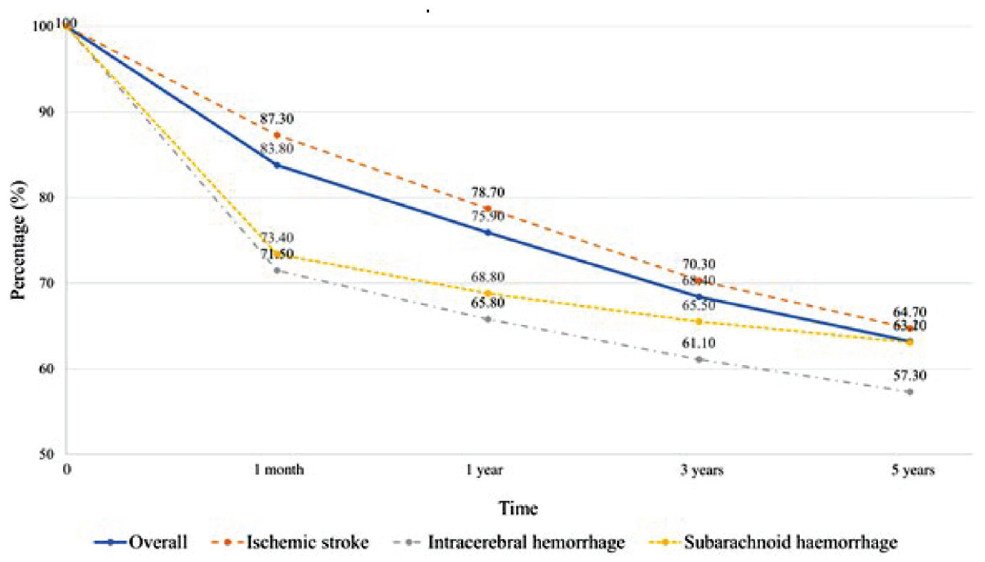Publications
Epidemiology of Arterial Hypertension in Kazakhstan: Data from Unified Nationwide Electronic Healthcare System 2014–2019
Sauran Yerdessov, Kainar Kadyrzhanuly, Yesbolat Sakko, Arnur Gusmanov, Gulnur Zhakhina, Dinara Galiyeva, Makhabbat Bekbossynova, Alessandro Salustri and Abduzhappar Gaipov
The in-depth epidemiology of hypertension has not been studied in Kazakhstan (KZ) yet. We aimed to investigate the crude; age and sex standardized prevalence, incidence, and all-cause mortality rate among hypertensive patients in Kazakhstan using a large-scale Unified National Electronic Health System (UNEHS) for the period 2014–2019. Hypertension was defined based on the ICD-10 codes (ICD-code: I10; I11; I12; I13). Of 1,908,419 patients, 1,186,706 (62.18%) were females and 721,713 (37.82%) were males. The majority of the patients (56.3%) were ethnic Kazakhs, 26.6% were Russians, and 16.2% were of other ethnicities. In 2014, the crude rates of prevalence, incidence, and mortality were 3661, 1396.1, and 33.1 per 100,000 population, respectively. The overall prevalence, incidence, and mortality rates among hypertension patients had a gradual increase over the period 2014–2019. The sex and age adjusted rates demonstrate the same trend throughout the entire period. We observed 71% higher risk of crude death in males comparing to females (Hazard ratio (HR): 1.71 [95%CI: 1.69–1.72]); Russian and other ethnicities had 1.56-fold (95%CI: 1.54–1.58 and 1.43-fold (95%CI: 1.41–1.45) higher risk of all-cause death compared to Kazakhs, and the elderly group had the highest risk of death (Hazard ratio (HR): 35.68 [95%CI: 28.11–45.31]) comparing to the younger generation, which remained significant after adjustment to age and sex. Overall, these findings show statistically significant lower survival probability in male patients compared to female, in older patients compared to younger ones, and in patients of Russian and other ethnicities compared to Kazakh.
Publication Page PaperINCIDENCE AND MORTALITY RATES OF STROKES IN KAZAKHSTAN
G. Zhakhina, B. Zhalmagambetov, A. Gusmanov, Y. Sakko, S. Yerdessov, E. Matmusaeva, A. Imanova, B. Crape, A. Sarria-Santamera, A. Gaipov
There is a lack of information on epidemiology of acute ischemic stroke (AIS), intracerebral hemorrhage (ICH), and subarachnoid hemorrhage (SAH) in developing countries. This research presents the incidence and mortality rate of stroke patients based on hospital admission and discharge status in Kazakhstan. The registry data of 177,947 patients admitted to the hospital with the diagnosis of stroke between 2014 and 2019 were extracted from the Unified National Electronic Health System. We provide descriptive statistics of socio-demographic and medical characteristics. Survival analysis using Kaplan-Meier estimation and Cox regression is performed. Among all patients, who had at least one episode of stroke, 84,255 (47%) were females. Majority of patients had an acute ischemic stroke (n=138542, 78%), while the admission of intracerebral and subarachnoid hemorrhage patients was notably lower (34262 (19%) and 5143 (3%) respectively). The incidence and mortality rates based on admission and discharge status in 2014 were 1,905 and 240 per million population (PMP), respectively, which were different in 2019 (1,884 and 271 PMP, respectively). In 5 years of follow-up period, AIS patients had better outcome than SAH and ICH patients (64.7%, 63.1%, and 57.3% respectively) (Figure 1). We describe for the first time in Kazakhstan an increase in the all-cause mortality rates based on discharge status of stroke patients, while the incidence rate decreased. We observed a statistically significant lower survival probability in ICH patients compared to ones who had an episode of AIS or SAH.
Publication Page Paper
